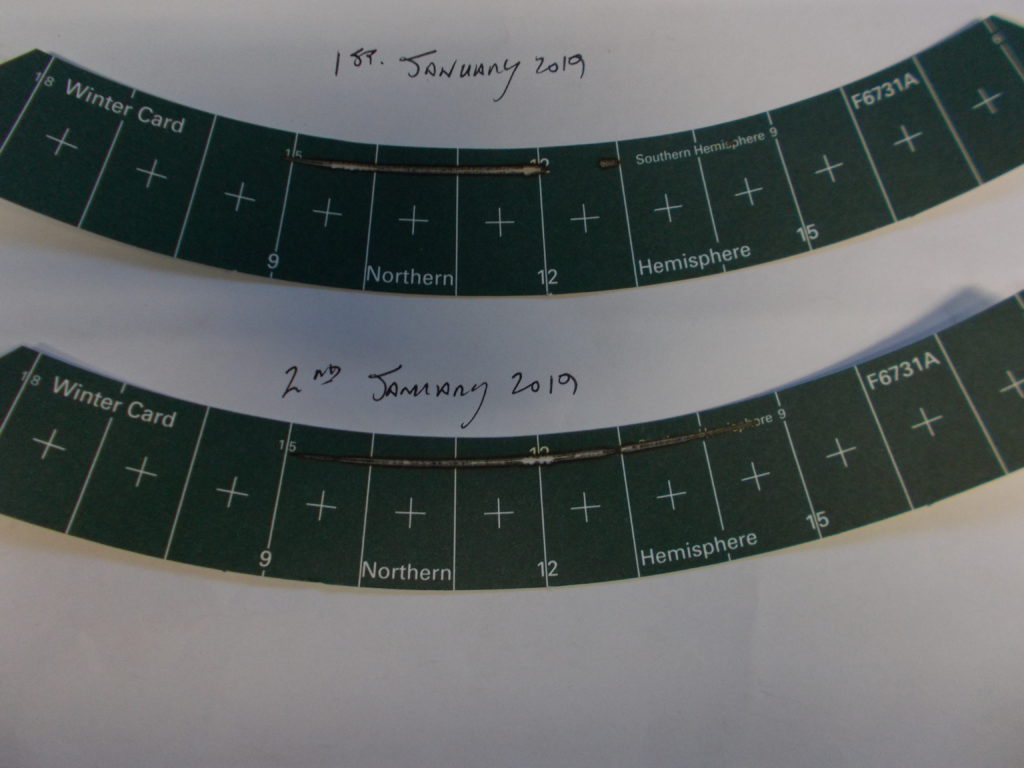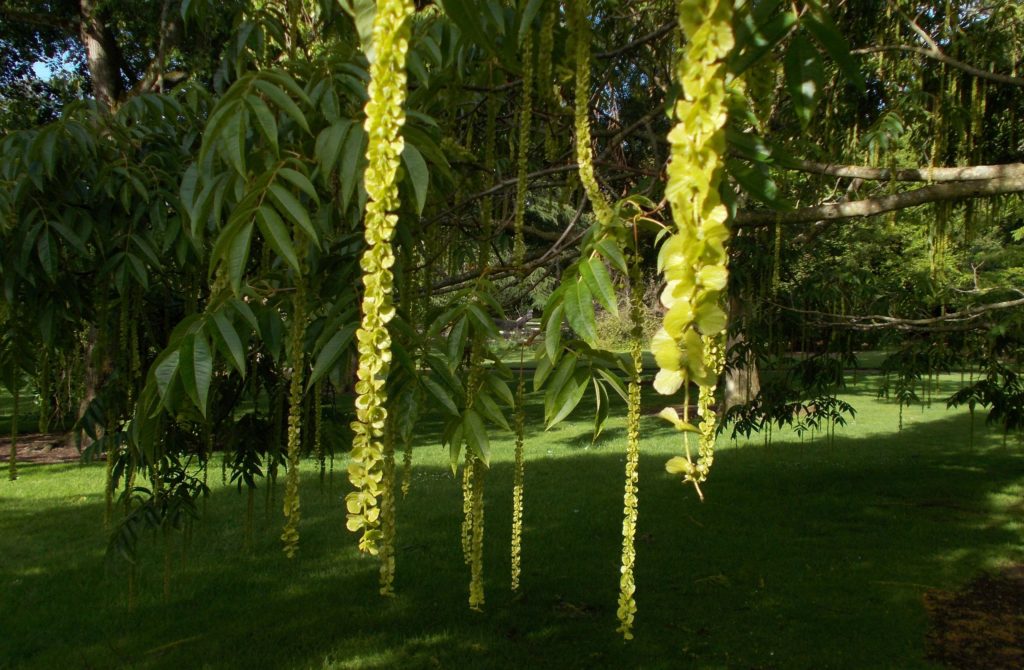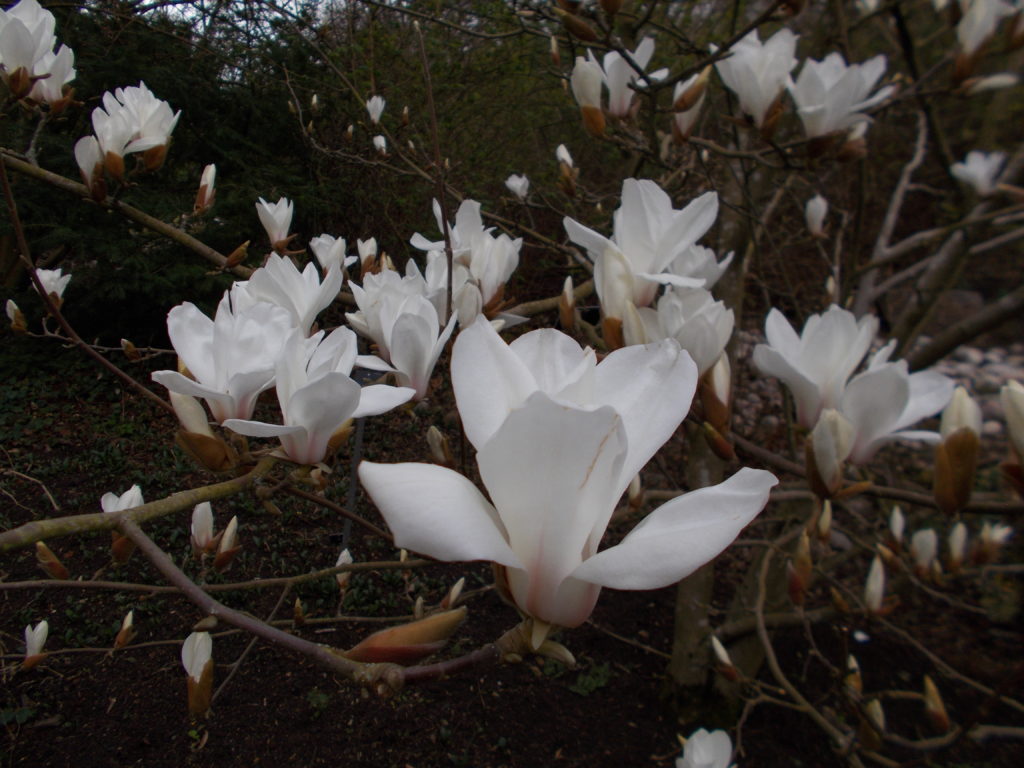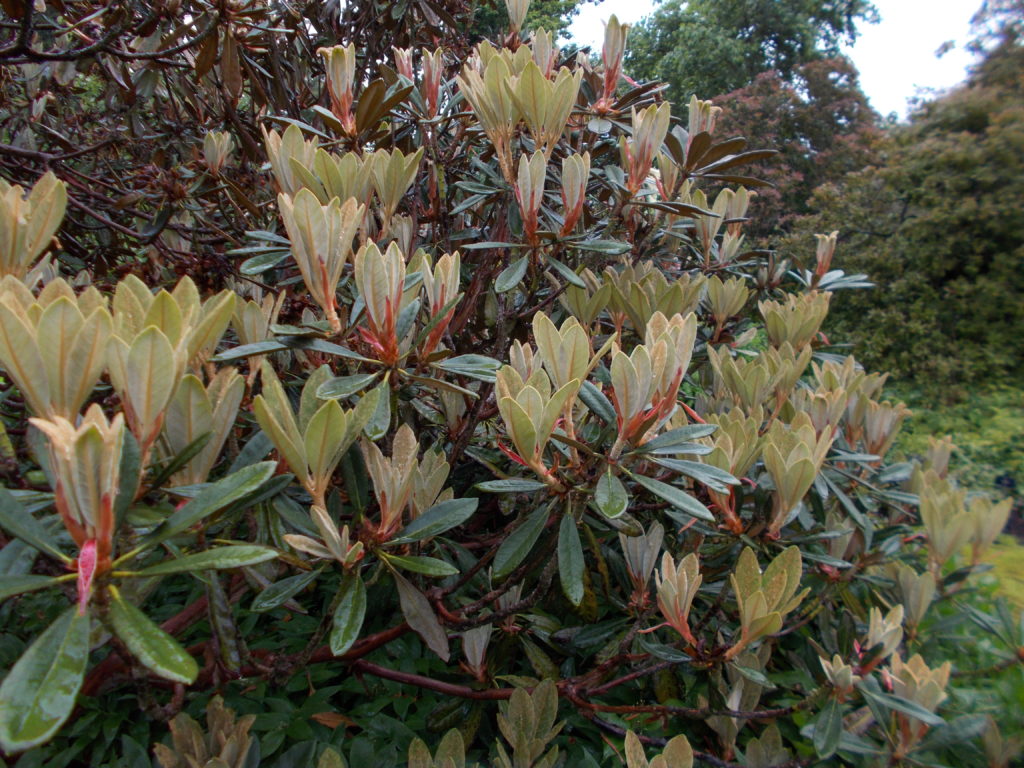2018 ended with temperatures in double figures, not as isolated incidents but repeated daily. Before dusk fell, the bells announcing the ice cream van touting for trade were audible. Roses bloomed and Parsley was picked for the steak pie and mash on the first.
A bright fresh New Year dawned with three full hours of sunshine; the 2nd even better, sunshine from 9.00am until 2.30pm then with intermittent bursts through the clouds until 3.00pm.
A result of the mild weather in December were the long red stalks of Rhubarb from the Yorkshire triangle joining bunches of Scilly Isles Daffodils in the shops. Here in Edinburgh the foliage growth on naturalised Narcissus was well advanced, yet no sign of flower stalks emerging.
Late afternoon on the 10th January neighbourhood children were out playing in their gardens which shows how lengthening days and the mild, dry weather has such an influence on our habits.
January recorded 12.2mm of rain, our average for the month is 66mm. The driest January since 1990; In contrast to this; gin sales rose by 23%.
A cold blast of air descended on the country in the middle of the month, we had already made the first cut of the lawns by then. Snow flurries fell and disappeared as rapidly. We were not afflicted by the deeper snowfalls that other areas of the country experienced.
February saw the warmest Valentine’s Day for 20 years. The warmth had an effect on the Winter Aconite flowers, draining the colour earlier than usual. Touching 15°C on the 15th February, the warmth brought out the last remaining rose in the garden, one day too late to save a florist’s bill!
These days in February saw extremes of temperature with a clear overnight sky allowing the warmth of the day to evaporate with overnight frost following. Tuesday 26th February saw Kew Gardens record the highest winter temperature at 21.2°C, here at the RBGE we recorded 14.9°C. By the month’s end we had recorded 16 days above 10°C, giving an average for February of 11°C. The month was dry with only 18.4mm rain and bright with 109.6 hours of sunshine.
As day length increased allowing more opportunity to work in the garden, the intensity of a drift of Snowdrop white was to be appreciated. The fading light intensified their colour while the Winter Aconites became invisible in the twilight.
Edinburgh was awash with blossom. Travelling through the city at every turn were trees covered in Cherry blossom. Visitor numbers to the Edinburgh Garden during February increased by 8.4% on 2018, 15.6% up at Logan.
Turning the calendar to March was like closing spring and opening winter. Having experienced the warmest February for decades we were not prepared for the cold spell and the rain that preceded storm Freya. This was a spell of that cold, wet rain that chills the body. The rain was much needed, ploughed fields and cultivated land was dry from devastatingly low rainfall of these past two months.
The plant that shone during the second half of February was Abeliophyllum distichum. Planted on the east bank of the Azalea lawn, sheltered by a tree canopy this deciduous shrub covered itself in pink flowers in profusion not seen here before. At the same time walking through the Garden the all-pervading heavy scent of Sarcococca filled the air.
14th March and the first day when real heat could be felt from the sun, the brightness enhancing the translucent fresh red growth of the Photinias. These early sprinters always brighten the Garden, just make sure you choose a good clone with the deepest red emerging shoots. A day of sleet and snow for Edinburgh mid-month while other parts of the country flooded. Storms and sleet did not stop the perfect shoots of Chives from developing. This sweet young growth is an early saviour perking up the flavour of shop bought salad leaves.
The spring equinox coincided with a super moon lighting the Daffodils. The following day, passing Saughton Park, warm weather enticed a “taps aff” moment for the youth of the city enjoying the skate park.
The changing of the clocks saw a corresponding change in the weather; temperatures dropped, a skim of snow on the Pentland Hills and a frost on lower ground. Still the Magnolias bloomed. This season Edinburgh was Magnolia central. The display in the Garden and within private gardens throughout the city was indeed spectacular.
Although March seemed a consecutive third dry month we had 80mm rain which was above the average and certainly much more than the 7.6mm that fell through March 2012.
On the 4th April, hailstones fell with such ferocity that they resembled a waterfall coming off the slate roof opposite. Cascading, ricocheting and flying over the gutters bouncing to the ground and then the added crunch underfoot. All soon disappearing with the sun. As a contrast Scottish Natural Heritage (SNH) issued a warning of fire risk in the countryside from wildfires, disposable barbecues and discarded cigarettes.
By mid-April the Edinburgh suburbs looked as though they were preparing for a Royal visit, all the privet hedges had burst into growth. An even gloss green, that could have come from a litre pot of paint evenly applied to each and every hedge. The freshness it brought to the streets was quite breath-taking.
The Easter weekend weather was memorable, the sun shone and temperatures rose into the 20’s. The sunshine recorder on the Palm House showed that a quarter of the month’s sunshine beamed down on us for the duration of the four days of the Easter weekend. 30,620 people visited the garden during the holiday weekend showing what a valued and treasured amenity the people of Edinburgh, visitors from the rest of the country and indeed around the world consider RBGE to be. Temperatures of 23°C on Easter Sunday brought out a Tulip festival. The petals splayed open to take advantage of the fine weather making the colour appear more intense. One of the Garden Guides even mentioned an infestation of greenfly; too early to contemplate aphids surely. This hot temperate weather we have experienced has disadvantages too.
April had lower than average rainfall, 33.8mm compared to the average of 44mm. There was only one day, 3rd, when any significant amount fell; 12mm. The soil continues to dry and with the foliage developing, soil moisture becomes critical for extension growth. The 100mm deep soil thermometer read 10 °C on 20th April, a sign that grass growth will speed up and a more frequent mowing regime will be required.
May commenced dry with no record breaking temperatures. Quite the opposite of the conditions we were to experience later in the month when it became miserable and unseasonably cold. Fothergilla major produced a profusion of white candles composed entirely of pin thin anthers. The lower temperatures muted the musty scent while it was in flower. On the day we decided to take the snowplough off the front of the utility vehicle the weather worsened and May 8th recorded a low of 3.6°C on the grass minimum thermometer.
Edinburgh recorded the warmest temperature in the British Isles on 12th May, coinciding with the flowering of Sorbus. The rancid smell that these flowers give off made all the more pungent with the warm sunshine.
Steady rain fell for about 24 hours on the 17th/18th May. Hardly a breeze meant that drops settled on the young foliage and flowers of woody plants, weighing them down. Looking around on the morning of the 18th the garden had a bedraggled, forlorn appearance. Lilac blossom wilted over on flexible stems, the long soft shoots of Roses bent to a disturbing degree. The last of the Tulips all sent to oblique directions, the need for a gentle breeze to help dry the foliage was essential. Then two days of warmth and sunshine and all looked as fresh foliage should.
Late May also saw the South facing fairways on Edinburgh’s golf courses fading to burnt brown, all relative to the reduced rainfall of the past few months. Despite two intense wet days, at the end of May SEPA’s message in its water scarcity report was a warning that Scotland was going into summer facing a water shortage and for growers to plan ahead preventing leakage, over watering and other wasteful usage. As gardeners how do we help? By adding bulky organic matter to the soil, looking after our earthworm population, when necessary by watering in the evening and only watering plants that would benefit from water. In addition, future planning our gardens to grow and plant drought resilient species and crops.
The 30th May was so dreary that not one of the neighbour’s solar powered lights were on as darkness descended. The last day of the month mirrored this and although not raining was damp with the Garden again hanging wet. The grass paths in the Rock Garden were covered in slugs. The ideal weather for them.
Having mentioned a water shortage, looking at the records for the month; May was a little wetter than average and with less sunshine; 177 hours compared to the 203.2 hours of sunshine that started the memorable summer of 2018. Of the 31 days of May we had rainfall on 19 but only three of these days were drenching downpours, the last of which managed to successfully take all the colour from the sprays of Lilac flowers. A timely task is to dead head, removing these brown spikes which spoil the look of the garden. What this weather successfully did was promote extension growth on the Rhododendron collection. Each and every plant was awash with fresh green shoots of good length. Looking through the copse in particular; the shoots flushing out evenly over the plants gave a fresh appearance to the area. Rhododendron aff. arizelum proving that even, regular rainfall could never be outdone by an irrigation system. The evenness and vigour of growth this season was proof of nature’s bounty.
Chilly for June were the words on everyone’s lips as double figure temperatures were elusive at the start of the month and rain kept falling. An early infestation of the fungal disease Red Thread appeared on the lawns caused in part by the wet weather this month. Yet, on a walk through the Garden as rain fell the air was filled with the scent of Philadelphus blossom. Paeonia ‘Rose Garland’ flowering under a dull sky produced perfect petals of a shade pinker than pink. In the copse the musky scent that we anticipate each year from Magnolia sieboldii ssp. sinensis did not disappoint.
Trachycarpus fortunei, the hardy palm with an umbrella of foliage crowning a bare stem excelled this summer. Giant panicles of honeycomb golden flowers were borne on plants throughout the city. Another plant excelling itself at RBGE was Pterocarya macroptera var. delaveyi. This Champion Tree within the UK and Ireland for girth and height produced a bountiful crop of green hanging tassels of extreme length.
Midsummer Day was bright from sunrise to sunset, recording just shy of 15 hours of sunshine with a top temperature of 21.4 °C over this weekend of long days in Edinburgh. Compare that to a day later, Monday 24th saw no sunshine at all. Torrential downpours and thunder led to localised flooding to the west of the city and traffic chaos for homeward bound commuters. The Met Office had issued a yellow “danger to life” warning for this period. In Paris a similar warning was issued but for heat. Parisians were told to seek designated cool spaces and offered free water as temperatures in excess of 40°C were forecast. The common thread in both cases are gardens and greenspace. Soft green surfaces allow water to absorb rainfall slowing the flow of run off to drains and watercourses which overload when 44mm rain fell in the space of an hour as happened in localised spots to the west of Edinburgh and in Stirling. Returning to the exceptional heat in Paris; again gardens and green spaces are known as cool islands within the built environment. Just two reasons to treasure and respect the skill of the horticulturist, the growth of the living plant and its environment.
Pink dominated as the flower colour for midsummer; Kalmia latifolia in the border to the west of the glasshouses and growing on the tufa scree at the alpine house; mounds of Alyssum spinosum were popular with pollinating insects. With shorter days in mind, a heavy crop of the pink hued, winged “helicopter” seed developed on Acer caudatum ssp. ukurunduense. By the 10th of July this pink pigment had washed out leaving bunches of keys ripening for autumn seed.
As for the weeds; this year the most prolific weed species to invade the garden has been Cleavers; Galium aparine. Hidden within the living collection were unnoticed sprigs of Galium that suddenly with a growth spurt put on two metres rising above the supporting vegetation to lighthouse status. Then the pulling session necessary to clear the crop before seed drop.
Twenty years ago, a walk in the Chinese hillside along the path planted with Hypericum beanii the bee activity in these yellow flowers was overwhelming. This year on a warm, sunny day there was activity but not the frenetic gathering of nectar and pollen as in those previous years. Studies attribute this decline in not just bees but pollinating insects in general to the trilogy of habitat loss, a changing climate and pesticide use.
A humid month with rainfall and temperatures high enough to prevent it seeming cold when working in the garden. In the second half of the month hot and humid weather gave rise to thunder and lightning with overnight temperatures on a par with the usual July daytime temperature.
Where have all the wasps gone? The warm weather means meals in the garden yet where are the wasps? Outdoor food attracted the odd flypast but no great numbers. These are pollinators too and are subjected to the same limiting issues that affect bees.
On the 23rd July, a month on from the last heat warning France issued, the country again issued a second red alert as temperatures rose to record levels over much of Northern Europe. We even resorted to putting a sprinkler out on Inverleith House lawn for the children to cool down under. This the day that Edinburgh experienced a maximum temperature of 32°C; the overnight low, 17.3°C. During the evening as the thunderstorm bypassed the city the air became so heavy you could almost cut through it. Statistics say that the ten hottest years have occurred in the past two decades. July 25th and Cambridge Botanic Garden recorded the hottest day ever recorded in the UK at 38.7°C.
A month of magnificent Hydrangea flowering. Did the heat and humidity have anything to do with it? More likely the hot, dry summer ripening wood last year. Whichever weather event, the display this year was certainly bountiful and much appreciated.
Following a day of torrential rain on Sat 27th July SEPA issued 6 flood warnings across the country. A pan European study now concludes that floods are more severe, with water volume rising 5 – 25% over the past five decades depending on the location. Yet a 55% higher volume of water than was recorded in floods 50 years ago in southern Scotland and northern England. Scotland and England have experienced greater flood severity than any other area in Europe.
August arrived with continuing yellow weather warnings and a drop in the temperature. This summer’s heat has been defined by the high overnight temperatures, not something we in Scotland are used to. However we are becoming used to the lush green growth that this weather produces. Lawns were on a continual cutting cycle and the herbaceous border was chocked full of growth and equally with flower. In the late afternoon as rain stopped and sunshine raised temperature and humidity the flowers were inundated with hoverflies.
Wednesday 7th August 3.30pm a sudden intense rainstorm combined with thunder and lightning saw rain dropping at a rate of 71.6mm per hour, only lasting for ten minutes but with such ferocity that localised flooding was inevitable and gutters and gulley’s certainly not coping. A total of 15.4mm rain fell during the day. Road and rail travellers continued to experience difficulties the following day due to the damaging effects of such a quantity of rain falling in so short a time.
An aberration this early in August were flowers, not few but plentiful, on Viburnum x bodnantense ‘Charles Lamont’. As a winter flowering shrub this seems to produce flowers earlier each season. Yet never appears to run out of energy, continuing to produce until well into the new year, each year preceding this one. In rough grass a smattering of Colchicum cilicium flowers were also appearing earlier than normal this season.
The rain continued, 109mm in the first week of August, yet the Phlox were mildew free and their flowers gave an exceptionally long burst of colour this year. We left August with a burst of heat and yes, yet more rain. Raspberry canes shot to three metres, too tall to survive the winter storms although the thought of the ripe fruit in 2020 is appealing; the canes do need reducing in height and tying in.
Total rainfall for the month of August was 140.8mm the average being 92mm. Couple this rainfall with above average sunshine (201 hours compared to the average of 160 hours.) and there is your explanation for the phenomenal vegetative growth this late summer. In comparison a wet month but not as wet as 2008 when we had 202mm rain and the most miserable 79 hours of sunshine. Overall this was the warmest wet summer recorded.
This year’s weather events illustrate a changing climate keep in mind the previous maximum temperature recorded in Britain was exceeded this summer and also in several mainland European countries including France. The hottest temperature recorded in the UK on the August bank holiday was at Heathrow. This is an area of hard surfaces, buildings and transport infrastructure that absorb the sun’s heat. The absence of living green surfaces contribute to this heat build-up. As we see increasing hot summers this should strengthen the argument for development and preservation of the living green areas.
Here the results of a trying growing season showed as three quarters of a billion fewer bottles of Champagne were made in addition it is forecast that 798 million less bottles of wine will be produced.
Temperatures on the weather map were in single figures as we progressed into September. The metrological autumn certainly felt chilly. Overnight of 10th September the tail end of Hurricane Dorian blew through tickling the leaves on the trees, mild in comparison to the devastation the Bahamas experienced at the beginning of the month. The month continued dry and sunny with several days in the 20°C. Late bedding especially the red Geraniums and herbaceous Salvia’s showing fine colour.
October arrived with the first frost during the night of the first. With the lower temperatures the Conkers started to fall from the Horse Chestnut trees. A good season with a larger and more prolific crop this year. In previous years the harvest has been much reduced. Possibly this is a reaction to the Horse Chestnut being placed on the IUCN European red list as a vulnerable species due to the decline in numbers caused by the leaf miner moth. On the 10th of October the first flower on the Winter Jasmine, Jasminum nudiflorum opened. The flowers first seen in early August on Viburnum x bodnantense are continuing to be produced. These both traditionally winter flowering plants.
Frosts cut in through the month slowing growth on the lawns and making leaf fall more rapid. November was wet, belts of torrential rain caused localised flooding but not on the scale experienced in northern England. Then to end the month a traditional scene of white frost covering all surfaces and no rise above the minimum despite the much-appreciated hours of bright sunshine. This autumn has been the wettest for many years with a cumulative total of 262mm rain; September to November and as if not dreary enough, November only recorded 40 and a half hours of sunshine in total.
December has been stormy, wild swings back and forth with the barometer needle signifying changes in pressure that then appear as wild wet weather systems passing through the country. Overall a mild month with a fleeting appearance of snow on the Pentland Hills, lasting barely the daylight hours. In the wee small hours of Sunday 29th the UK recorded the highest night time temperature in the UK, for this late in the year. Cassley in Sutherland experienced 16.8 °C. This warmth goes some way to explaining the growth in lawn grasses and dormant clumps of herbaceous plants showing emerging shoots in the depths of winter.
Increasingly we are experiencing socially devastating and economically destructive weather events. As gardeners how can we mitigate these destructive influences? By continuing to plant and grow, this is the base line. Choose lawns, borders and hedges in preference to monoblock hard surfaces, decking and fences. Look upon your garden, however tiny, as a carbon capture area. One of many through the country that acts as a catchment for rainwater, slowing the flow through the soil before draining off into the land. Plants absorb and take up soil water. Growing a diverse range of plants encourages bird and insect life. Does your garden have a resident Robin? If not, can you develop a garden habitat to encourage one?
Another way to progress this low carbon ethos is by using less mechanised equipment. Think edging shears not a strimmer; think rake not a blower or leaf vacuum. Use a long-handled wire brush to scrape the weed seedlings out of the monoblock and paving slab joints before they get to the stage of blasting out with a power washer. Consider holding your nerve and cutting the hedge once only during the growing season.
I am not advocating a return to the dark ages, more a return to a gentler way of gardening. One where noise and fumes are reduced. Maybe it is time we were just a little more mindful in how we garden. In general, use your energy not electrical or fossil fuel energy sources to garden.
Consider putting these thoughts into action as the days lengthen.
Best wishes for 2020 and a successful and innovative year of gardening.





Liz
Loved reading this post, what a great way to sum up last year!